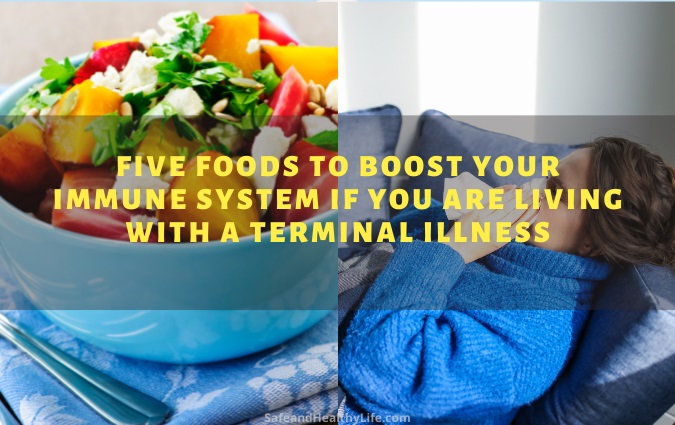[ad_1]

Terminal illness patients usually take a hit to their immune system, generally because the treatment and medications can deplete the white blood cells hence weakening the body’s ability to protect itself.
Coupled with the well-studied immune boosters like enough sleep and stress-relieving methods, boost your immune system by including a nutrient-rich, natural balanced diet.
For instance, low carbohydrate foods are highly recommended for individuals with type-2 diabetes for managing blood sugar, especially when insulin injection is involved.
With nutrition given such an emphasis on boosting the immune system, this post outlines the type of foods you should take to keep your immunity strong when living with a terminal illness.
1. Fatty seafood
Fish like sardines, tuna, mackerel, salmon, and herring are rich in omega-3 oils, high in protein, and low in saturated fats essential for a healthy heart, hence reducing cardiovascular diseases.
Though omega-3s may have little or no effect on type 2 diabetes directly, they can still have significant benefits in enhancing the functioning of immune cells for a better immune system.
Additionally, a component in omega-3 oils called EPA effectively enhances the activities of white blood cells, which fortifies the immune benefits. And according to studies, this effect has significant effects and can happen fairly quickly, precisely within a week.
Furthermore, fatty seafood appears to lower inflammation rates, hence improving the functions of blood vessels and reducing triglycerides. If prepared without sauces, fatty seafood contains low carb ideal for some chronic conditions like diabetes.
For example, a 5 ounce serving of salmon without sauce contains only 5grams of carbohydrate.
2. Chicken peas.
Proteins are known for strengthening the immune system the same way major immune-boosting micronutrients like zinc, iron, vitamins A, D, E, and selenium.
Having that in mind, as a person living with a terminal illness, you need to consider adding a humble chickpea. This is a plant-based protein source that is known for being high in zinc minerals.
According to the U.S department of agriculture, a ½ cup serving contains approximately 9% of the required daily value.
Zinc is an essential requirement for the function of white blood cells, which are vital in keeping diseases at bay. In addition, zinc is a boon to your heart health, thus preventing risks of cardiovascular diseases.
What’s more, it is helpful for diabetic patients because high blood sugar can have adverse effects on your heart if left over a long period.
Although it is high in carbohydrates, chickpeas are an excellent source of fiber. Precisely it offers about 26% or 6.55 g of the daily value per cup. A diet high on fibers is associated with healthier weights and improved insulin sensitivity.
3. Carrots.
Vitamin A supports our immune system through various cellular processes, and one of its top sources is carrot. It contains beta-carotene, which has a high content of vitamin A. What’s more, it is low on glycemic content, meaning it is not likely to cause sugar spikes in people with diabetes,
Usually, internal illness can lead to eye damage resulting in poor vision and other risky issues such as glaucoma and cataracts. Luckily, carrots contain essential elements for eye health, an important factor for those living with terminal diseases.
4. Walnuts.
This is another plant-based vitamin E source-a great antioxidant that also helps in boosting the immune system and helps regenerate cells in our bodies.
This is important since a person facing end-of-life illness needs new and strong cells to replace the ones depleted by the particular disease and their treatments.
Walnuts have low carbohydrates, and therefore, it has a negligible effect on glucose levels. It is also a great source of omega-3 oils which we have learned that reduces inflammation in terminal illness patients.
Because internal illness patients usually suffer from poor appetite due to changes in metabolic processes and reduced body activities, walnuts are ideal for them because they activate a part of the brain involved with impulse control and appetite.
5. Red bell pepper.
Since internal illness patients should avoid excess sugars even from fruits, red bell pepper makes a perfect alternative for the same. It contains vitamin C, which is crucial in boosting our immune system and eliminating free radicals, which cause damage to the body cells.
Additionally, red bell pepper is important for wound healing and skin health due to its involvement in collagen formation. Note that skin problems and wounds are some of the common issues associated with a terminal illness.
Conclusions.
Individuals with terminal illnesses often experience symptoms that reduce their appetites, such as pain and nausea. The illness may also interfere with their taste buds, making the food taste sour, bland, or salty.
It is advised not to force them to eat but to give them food bit by bit whenever they feel like eating something. Fatty seafood, chickpeas, carrots, and walnuts are among the best foods they need to eat.
However, due to the underlying factors of terminal illness patients, their diets should not be restricted. They should eat whatever they want when they feel like eating.
About The Author:
Beryl Miller is a freelance content writer who loves to share her ideas on health, wellness, and fitness topics. She has written and ghost-written for major health journals and publications. When she is not reading about general health, she is surfing or skateboarding
[ad_2]
Source link




